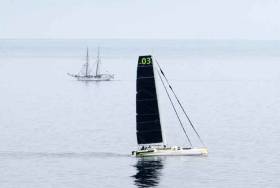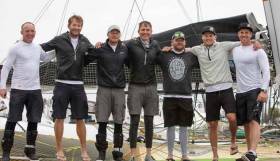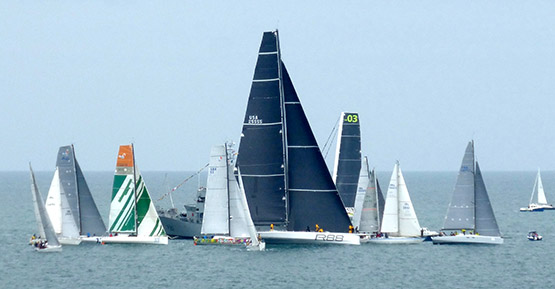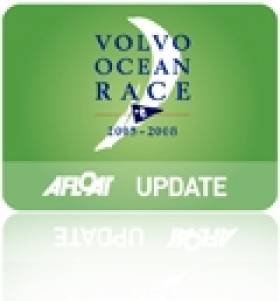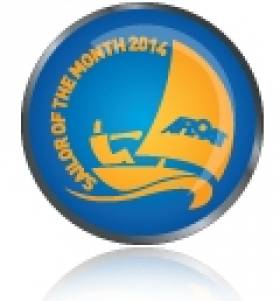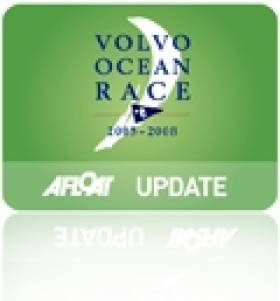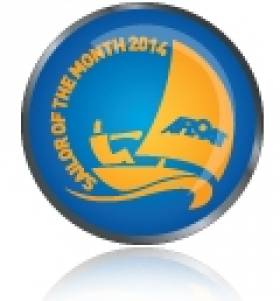Displaying items by tag: Justin Slattery
County Cork's Justin Slattery, a double Volvo Ocean Race Winner, and the rest of the Phaedo 3 crew are expected into Hawaii in the early hours of Tuesday am, hopefully with the WSSRC Transpacific Record in the bag.
As Afloat.ie reported earlier, they pulled out in the fog from the Long Beach dock in California last Friday morning. Lloyd Thornburg and his crew aboard Phaedo3 waited for several hours for the wind to fill in at Port Fermin, the boat took off at 21:40:15 (UTC) towards its final destination of Diamond Head in Hawaii.
The previous record was set by "Lending Club 2" back in July 2015 with a time of 3 days 18 hours & 9 seconds.
On board for the record attempt is: Lloyd Thornburg, Brian Thompson, Justin Slattery, David Swete, Peter Cumming, Fletcher Kennedy & Henry Bomby
You can follow them on the tracker here: my.yb.tl/Phaedo3/2262/
* News from Brian Thompson on board, we are expecting them into Hawaii in the early hours of Tuesday am:
"......It's been full on here, very hard to type anything since the start.. inside the last 500 miles and the record is still on if we keep the speed up.
Its blowing 25 knots with more in the squalls and we are tearing downwind towards Honolulu..
The first night was rough as expected with 30 knots plus on the beam and a big sea state. We had 3 reefs and the J3 which is our storm jib up most of the night.. we lost some time there but the second and 3rd day have been keeping up with a routing pace..
Everyone pushing hard to get this record, any off watch time is spent making some freeze dried food and trying to sleep inside this rally car going full speed..."
Pulling out in the fog from the Long Beach dock in California last Friday morning was Lloyd Thornburg and his crew aboard Phaedo3 headed towards the official start point of the WSSRC Transpacific Record writes Rachel Fallon Langdon.
After waiting for several hours for the wind to fill in at Port Fermin, the Round Ireland speed record holder took off at 21:40:15 (UTC) towards its final destination of Diamond Head in Hawaii.
The previous record was set by "Lending Club 2” back in July 2015 with a time of 3 days 18 hours & 9 seconds.
On board for the record attempt is: Lloyd Thornburg, Brian Thompson, Justin Slattery, David Swete, Peter Cumming, Fletcher Kennedy & Henry Bomby.
Peter Morton's Carkeek 40+ 'Girls on Film' Wins 2016 One Ton Cup
It was fifth time lucky for Morty, but the wait is now over. Peter Morton's Carkeek 40+ Girls on Film has won the 2016 One Ton Cup. The Cowes based team that included Ireland's Justin Slattery were worthy winners having scored no worse than a fourth in nine races. Peter Morton has come second in the One Ton Cup on two occasions and the attempts to win the prestigious trophy span over three generations.
Royal Cork's Antx skippered by Anthony O'Leary finished eighth in the 13–boat fleet
“It has been unfinished business.” smiled Peter Morton, rinsed in champagne. “The team on Girls on Film have ben absolutely fabulous. I would also like to thank the Royal Southern Yacht Club and Principal Race Officer , Stuart Childerley and his team for outstanding race management. Also Rob Greenhalgh for coming up with the idea of the FAST40+ Class and putting it together. For those of you that haven't won, I would say just be patient, your time will come.”
Girls on Film: Peter Morton, Darren Marston, Phil Pafford, Nat Ives, Justin Slattery, Ash Curtis, Toby Mumford, Duncan Yeabsley, Nick Butt, Dirk de Ridder and Dave Lenz.
Alex Mills at the helm of Ker40+ Invictus was runner-up, Invictus tactician and FAST40+ Class President, Robert Greenhalgh, congratulated Peter Morton and the Girls on Film crew. “At the beginning of the season, we didn't really know what to expect. The class has grown far quicker than we expected and it is continuing to attract more owners and sailors. The FAST40+ is an ideal boat for the Solent and during the season, the racing has got tighter and tighter. The One Ton Cup is our biggest event and to have nine boats make the podium just shows how competitive the FAST40+ Class is.”
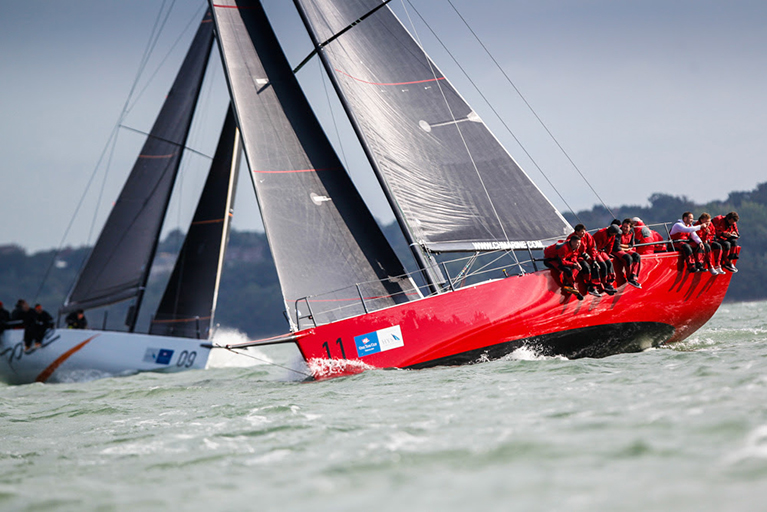 Anthony O'Leary's Antix competing in the One Ton Cup. Photo: Paul Wyeth
Anthony O'Leary's Antix competing in the One Ton Cup. Photo: Paul Wyeth
On the final day of racing, Mike Bartholomew's South African GP42 Tokoloshe was the winner of the penultimate race of the regatta and Bill Coates Texan Ker 43 Otra Vez finished the One Ton Cup in style winning the final race.
The One Ton Cup owned by the Cercle de la Voile de Paris, presented by Hamble Yacht Services and organised by the Royal Southern Yacht Club, took place between 16-18th September in the Solent, UK. Nine races completed with a mixture of windward-leeward and weighted points factor longer races.
Full Results from the One Ton Cup here
At 704 miles long, with a course along coastlines of almost infinite variety, the Round Ireland Race was always a complex event for post-race analysis even when fleets amounted to only three dozen or so. But for 2016 in the first year of sponsorship by Volvo Car Ireland, the number of starters soared to 63. And the inclusion of multi-hulls for the first time since the initial pre-RORC race of 1980 added further depth to the eclectic nature of the fleet, which was already an extensive array, as it ranged from small craft like a J/97, a First 31.7 and a Sunfast 3200, to one of the current superstars of world sailing, George David’s Juan K-designed canting-keeled Rambler 88. Having provided us with 17 up-dates during the six days of the race, W M Nixon takes a final overview.
Here’s to Yellowbrick, the friend of armchair sailors everywhere. In the old days, trying to analyse or explain the unfolding story of the biennial Round Ireland Race was a formidable challenge. And you could be talking about it to people very few of whom had ever sailed round Ireland, while others didn’t even know it from the land, as they have been availing of sunshine holidays ever since cheap air travel arrived.
Thus there are many who know more of the coasts of Spain, Portugal and Greece – or even the Scottish Hebrides and the Isles of Scilly - than they do of Mayo and Donegal. And having experienced both those Irish counties in their more perverse meteorological moods in the course of several races round Ireland - not to mention many non-racing cruising circuits – I have to admit that I can see their point of view.
The Yellowbrick tracker for the Volvo Round Ireland Race 2016 wraps Ireland in its web. TriLogic went furthest east after the start, the three MOD 70s went furthest south off the south coast and furthest west off the west coast, Rambler 88 went furthest northwest, and Pegasus of Northumberland went to the Isle of Man but came back to cross tacks yet again with Teasing Machine, this time at Skerries as the Machine came south from Dundalk Bay.
"Round Ireland 2016 is in a special league of its own"
Yet the round Ireland race is addictive, and for those who have done it in the past, particularly those who have done it several times, it’s a bit of a pang to see the fleet go off and not be part of it. Even with all the modern equipment and boats which are obviously faster, it’s still a very worthy challenge. And it induces a special post-race camaraderie among crews who, in racing terms, have been at each other’s throats since the start.
After each biennial staging, something new has always turned up to add to the sailing history books. But the Volvo Round Ireland Race 2016 is in a special league of its own in this category, so much so that far from just adding something to the history books, it probably deserves a book of its own.
In fact, you could write a book about the fantastic start in which Rambler 88 gave a Masterclass in discerning emerging gaps beginning to appear in a melee of sometimes confused smaller bats. Despite her huge beam she came cleanly through to a peach of a start right on the committee vessel LE Aisling, bettered only by Eric de Turckheim’s A13 Teasing Machine while smaller craft which thought they’d done better found they’d been OCS, which led to a slow and painful return against a strengthening ebb to re-start.
Rambler’s miraculous start, finding gaps where none had existed ten seconds earlier. Photo: W M Nixon
Fortunately in making some sense of what happened afterwards, we can take a precise positional overview by looking at the Yellowbrick tracking as it was at virtual completion yesterday afternoon. It may look like a right cat’s cradle of lines all eventually getting back to Wicklow, but there are stories to be drawn from every part of it.
In the first beat from Wicklow Head down to the Tuskar Rock, very few boats tended to the east, and it certainly didn’t pay off. The one who went furthest east was the 50ft Trilogic, Hugo Carlsson-Smythe’s trimaran, which ultimately retired during the course of the race with gear and sail problem, so we don’t know if ultimately she would have overcome this initial tactical error.
The mono-hull which tacked furthest east was Chris & Patanne Power Smith’s J/122 Aurelia (RStGYC), but she then put in a good showing in the long beat along the south coast and got herself back in the hunt, although off the north and east coasts things didn’t go quite so well, but in the end she placed 3rd in IRC 2 and 18th in IRC overall.
"Teasing Machine made a proper job of tide-dodging"
While the bulk of the fleet were still struggling against foul tides down the Wexford coast with Teasing Machine showing how to make a proper job of tide-dodging inside the Wexford banks, out ahead the biggies were splitting into their two parts of this fleet of four parts.
Although the reckoning was that conditions might just fall the right way for a new record, the three MOD 70s first had to find a breeze to raise them above the 12 knots which they occasionally fell back to as they came on starboard out past the Coningbeg Light. Thus it’s Musandam-Oman, Phaedo and Concise which are those three tracks which go way to the south. As they were so close to each other in performance, they sailed as a pack, so there was an element of covering as much as strategy in this, but in these early stages it was Ned Colllier Wakefield aboard Concise who was making the pace, with Phaedo next in line, while Musandam seemed to find it difficult to obtain quite the same speed.

The first hint of light in the east in the sky as the MOD 70 Musandam-Oman closes in on the Wicklow finish for a last-minute takeover of the line honours lead on the water, after her sister-ship Team Concise had led for most of the race. Photo: Mark Lloyd
Perhaps Irish sailing superstar Damian Foxall aboard Musadnam was slightly over-awed by it all, as he hadn’t been aboard Musandam when she set the new open Round Ireland record back in May 2015, and in an interview before the race (see below), he revealed that he and Justin Slattery – who was on Lloyd Thornburg’s Phaedo - were both Round Ireland virgins. They’ve been so busy building their international careers in other parts of the world that racing round their home island had never come up on the radar.
Whatever the reason, it was Concise which was least fazed by the challenge, she stayed closely in the lead, and after they’d tacked and started ripping up the west coast in the rising sou’west winds of Sunday, it was Concise which recorded the MOD 70’s best speed of 41.56 knots. But as they admitted afterwards, they weren’t right on the edge when they his that mega-speed in a growing Atlantic swell – they were beyond it.

Just outside a two day elapsed time, George David's Rambler looked every inch a winner in her debut Round Ireland race. Photo: Afloat.ie
After her glorious start ten minutes ahead of the MOD 70s, Rambler was going so well in the moderate southerly that she was past Arklow before the trimarans came through, but soon they’d disappeared ahead, and thus for the reminder of the race Rambler 88 was entirely on her own, thereby providing Part 2 of our four part round Ireland fleet. Although she’d been holding the IRC overall lead for a while, at various stages she’d dropped back as smaller craft got clear of foul tides. But once she was past the Fastnet and beginning to build her speed up the west coast in rising breezes, she was soon featuring among the front runners on all counts.
If anything, the weather felt almost Autumnal off the west coast, it had seemed slightly spring-like as warmer weather spread in while the leading big boats were far at sea seeking breezes off the south coast, and there was decent sunshine while the larger boats of the fleet were shuttling from Dun Laoghaire down to Wicklow on the Saturday morning for the start. But on the Thursday night in Dun Laoghaire when it was open house at the Royal Irish YC to meet the heavy hitters, a local weather anomaly was giving a temperature of 9 degrees Celsius which had been winter by anyone’s standards, it was certainly experienced but fortunately it wasn’t to occur again.
With the leading big boats zapping up the west coast on Sunday as south to sou’west winds continued to freshen, records were once again top of the agenda. But this was all of academic interest to the main part of the fleet bashing its way along the south coast, for as Sunday went on, conditions became increasingly rugged. Yet it was not without its local oddities – for a period on Sunday afternoon, there was very little wind indeed in an area close in on the entrance to Cork Harbour, and the spread of breeze was so uneven that the tracker revealed some boats taking rather desperate gambles to try and find steadier conditions.

Mark Mansfield and Maurice “The Prof” O’Connell on Dave Cullen's J109 Euro Car Parks, the IRC3 winners. Photo: Afloat.ie
One boat which did notably well during this stage was Dave Cullen’s J/109 Euro Car Parks. With Corkmen Mark Mansfield and Maurice “The Prof” O’Connell calling the shots, they gave a masterful demonstration of how to work the bays slugging west beyond the Old Head of Kinsale.
“Working the bays” doesn’t necessarily always pay off, and in fact it didn’t work so well for other boats near Euro Car Parks. So clearly an important factor in the successful use of this ploy is to have a boat which is out-sailing everyone else in any case, and it was noticeable by this stage that Euro Car Parks had worked out a formidable lead on all the other J/109s while she herself was in hot pursuit of Paul O’Higgins new JPK 10.80 Rockabill VI, racing with the noted talents of Mark Pettit and Brian Mathews on board.
"Rockabill VI was a very slippy performer"
As Sunday evening and night went on, the Fastnet became increasingly difficult to get past as the area of steadier fresher breeze moved to the north. Thus while bigger boats such as Alan Hannon’s Reichel-Pugh 45 was making hay up past the Blaskets with a performance which suggested that she a going better and better as her Lough Swilly YC crew became accustomed to her ways, back down the line off the mouths of the great rias of the southwest at times the wind was all over the place, and Euro Car Parks was one which suffered, head off south of Dursey Dound, and forced to tack seaward in unspeakably lumpy sailing conditions.
By this time Rockabill VI was showing she was a very slippy performer, and the long run up the west coast was brilliantly sailed by her talented crew, so much so that by Tory Island she’d opened out a lead of 40 miles on Euro Car Parks, which looked unassailable.
But for others even thinking about Tory Island was still way off the radar, as many boats reckoned they’d taken a ferocious battering through the latter part of Sunday, and there were retirals at all levels of the fleet. Meanwhile away to the east the oldest boat in the race, Darryl Hughes’s 1937 Tyrell of Arklow 43ft–gaff ketch Maybird was making only very slow progress and she’d sustained damage aloft and to sails, so she went into Dunmore East and kept the crew strictly on board and out of contact with the shore while they made repairs and then, most gallantly, they put to sea again and eventually after another two days of slow progress to windward they had the freeing of sheets at Mizen Head within sight, but then it was discovered that there was a major problem with the engine, so they retired regretfully into Baltimore.
By this time the great dramas of the record finishes at Wicklow had been played out through Monday. So long as there’s breeze your ordinary North Channel fair or foul tides aren’t the major consideration for he MOD 70s, it’s the presence of wind which is the primary consideration.
Sunday evening found the MOD 70s shaping themselves into the North Channel and fetching through with all still close together and Concise still just leading, but from the South Rock on it was hard on the wind or beating to get to Wicklow. Musandam was still trailing the other two, so she took a brief slant towards Dundalk Bay and then went on to starboard to pace with them about two mioles further westward, bringing her in closer to Howth than Concise or Phaedo, and putting her in a better breeze as the wind started to play tricks in the dark of the small hours off Bray.
Everything was gettingly nail-bitingly tense, and south of Greystones, Phaedo and Concise were slowing markedly, so Musandam came up from astern and took a bit of an offing, finding better breeze only a short distance offshore which carried her right to the line at Wicklow to finish ahead and created an absurd new record of 1 day 14 hours and 37 minutes, with Phaedo 3 six minutes astern, and Concise – which had so gallantly led for most of the race – coming in another minute later.
Follow that, as they say, but somehow Rambler 88 managed to outdo the drama, as she did the final stage from Rathlin Island to Wicklow in just part of the one span of daylight on Monday. But by the time she came calling the wind had veered and thus she was able to lay the whole way down the Irish Sea to the finish, and was travelling at full chat as she came into the line.
While a mono-hull record within two days was no longer possible as she’d sailed 790 miles in all thanks to that long tack to the south in search of better breeze through Saturday night and Sunday morning, nevertheless she still made an almighty dent in every other mono-hull record by finishing in a time of 2 days 2 hours 24 minute and 9 seconds.
There was still some bite to the winds, but even in a poor summer such as we’re currently experiencing, the fact that the sou’west to west breeze had now been blowing moderate to strong and more for more than three days was increasing the likelihood of calm patches, and a general falling away in wind strength.
So gradually the crazy notion took hold that not only would the popular Rambler 88 be lauded as the new all-out mono-hull record holder, but she might even manage to win the race on corrected time. Certainly the holes in the wind now began to appear with increasing frequency, and none more so than for Rockabill VI as she rounded Inishtrahull, the most northerly point of the course, on Tuesday.

Rockabill VI – a new JPK 10.80 design. Photo: Afloat.ie
The O’Higgins crew came up against what was soon known as the Great Glass Wall of Inishtrahull. Rockabill and the three other boats in her immediate neighbourhood all came to such a complete halt that tracker-followers assumed they must all have fouled lobster pots. But they were simply and totally becalmed. They made no progress for three hours, yet boats close to the east were still bustling busily towards Rathlin Island, while boats close to the west were trundling merrily in from Tory.
So after the episodes of winter and spring and autumn, Rockabill was experiencing a brief bit of summer she could have well done without. Finally she got going again, but by this time Euro Car Parks had sliced a huge 20 miles out of Rockabill’s 40 mile lead, and thereafter it was Euro Car Parks ahead in IRC 3 on corrected time. In other classes, solid performances and reliability in strong winds had been rewarded, and in IR2 the beautifully-prepared Cornish-based Swan 47 Sarabande (Rob Mabley) had a lead she held to the finish, while in IRC 4 we were witnessing one of the great performances in the race, with Patrice Carpentier’s Sunfast 3200 GROUPE V tenaciously staying in front throughout, quite a showing as she was also leading the two-handed division.
As the race drew to a close through Wednesday and Thursday for this main part of the fleet, other consistent performances were being rewarded. Eric de Turckheim’s Teasing Machine was both consistent and brilliant, and on Wednesday tacking down the southern part of the North Channel, she was neck and neck with Ross Hobson’s two-handed canting-keeled Open 50 Pegasus of Northumberland.

French entry Teasing Machine was both consistent and brilliant. Photo: Afloat.ie
But while Pegasus elected to continue on starboard right over to the Isle of Man as can be seen on the tracker plan, Teasing Machine’s crew took a completely different choice, they went right to the southwest, and then tacked to curve across Dundalk Bay close past Clogher Head until the two boats met again at Rockabill, following which they paced together down to Wicklow where a bit of slick tacking saw Teasing Machine finish ahead, but by this time it was akin to bear-baiting, as the crew of the big Pegasus were boggle-eyed with exhaustion.
Teasing Machine’s time put her behind Rambler 88 on corrected, so the crazy dream was becoming reality, but that is in no way to detract from the de Turkheim crew’s performance, it was a superb playing of the hand they’d been dealt, They were comfortably ahead of Class 1 and 2, and soon out of sight on the determined little battlers of Classes 3 and 4, who until then had been snapping at their heels.
Meanwhile, between the big’ uns well finished, and the little’ uns still battling far at sea, there were several Steady Eddy performances whose reward was on its way, and none more so than for RORC Commodore Michael Boyd of the Royal Irish YC. His Fist 44.7 Lise was always there or thereabouts, and on Wednesday evening she was off Dublin Bay as the tide turned foul, but she kept beating on steadily towards Wicklow and got finished before midnight with the bonus of a local breeze, and was immediately sitting pretty at second in Class I well ahead of Katsu in third, and looking good for third overall behind Rambler and Teasing Machine.
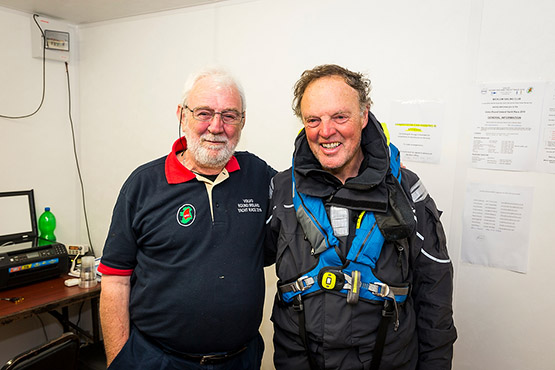
Midnight encounter. Race organiser Theo Phelan with RORC Commodore Michael Boyd after the latter had brought the First 44.7 Lisa across the Wicklow finish line to take third overall. Photo: David Branigan
But that third overall needed a bit of waiting, as the Class 3 front-runners of Euro Car Parks and Rockabill VI were still in with a chance, while Class 4’s GROUPE V and Stephen Quinn’s gallant little J/97 Lambay Rules were also in contention, but it was not to be. The minutes slipped away, the hours ticked by, and in the end over a course of 704 miles it was waterline length which counted as a fading breeze and much windward work saw the little ‘uns lose out. But my word, they had one impressive race amongst themselves.
The results are still being analysed as we write this, and it was only on the Friday that Rambler was finally confirmed as overall winner, with Teasing Machine second and Lisa Third. As for Class winners, they were (1) Teasing Machine, (2) Sarabande, (3) Euro Car Parks, and (4) GROUPE V, but GROUPE V lost her two-handed class lead to Begian Michael Kleinjans’ Open 40 Roaring Forty 2 which was another steady performer.
"All credit to Wicklow Sailing Club’s Theo Phelan and his team"
In all, it was a wonderful race, a magnificent sporting event from which any keen sailor can take much of interest and even more of entertainment and excitement. All credit to Wicklow Sailing Club’s Theo Phelan and his team who have kept this event going through the thin times, and have been ready and waiting to see it come to a new flowering with sponsorship from Volvo Car Ireland.
But all the background organization would have been meaningless without a fleet of boats and their crews game to take on the 704-mile circuit of an island set in an exposed location on the lee side of the Atlantic ocean, and in following this race it has been particularly encouraging to see the improving performances of certain boats as their relatively novice crews get to grips with the challenge they’ve taken on. Needless to say it was also a case of the Old Dog for the Long Road, and Ian Hickey’s Granada 38 Cavatina was again in the frame at the fiish in Class 4.

Top of the class - a notable performance by the sailing school crew from the INSS in Dun Laoghaire. Photo: Afloat.ie
Notably outstanding was the Irish National Sailing School’s Reflex 38 Lynx from Dun Laoghaire, skippered by Kenneth Rumball. She was always in competition, but as the race went on she seemed more in competition than ever, until at the finish she clocked in at fourth among all those hotshots in Class 3, close astern of Conor Fogerty’s Sunfast 3600 Bam at third, and placed tenth overall in fleet. The crew of Lynx have had one excellent lesson in offshore racing.

The essential post-race de-briefing – the crews of Euro Car Parks and Rockabill VI, leaders in Class 3, get together in Wicklow SC on Thursday afternoon after five days of racing against each other round Ireland. Photo: W M Nixon
Volvo Round Ireland 2016 selected results
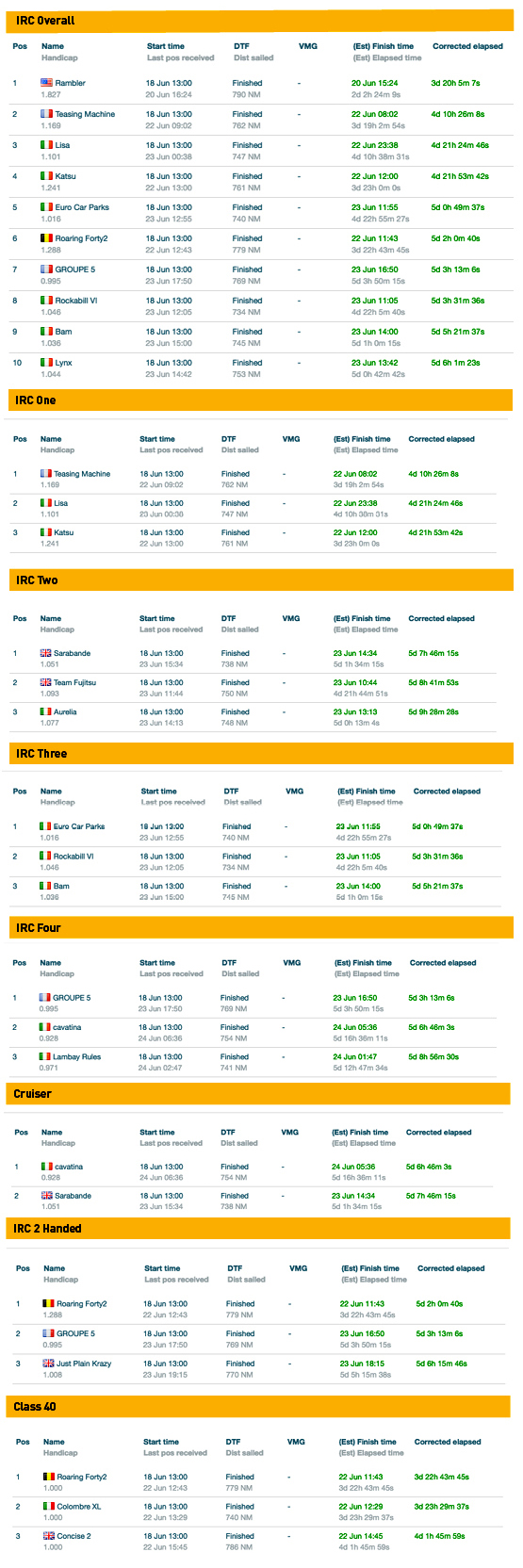
See Round Ireland tracker here Afloat's Round Ireland 2016 coverage is here and download overall results here
Justin Slattery Awarded Top Irish Cruising Club Honour
Double Volvo Ocean Race winner Justin Slattery has been awarded the J B Kearney Cup by the Irish Cruising Club (ICC).
The J. B Kearney is awarded to individuals for their outstanding contribution to Irish Sailing. The committee unanimously agreed to award Justin the trophy in recognition of his two decades of racing at the highest level, including five Volvo ocean races and for being a leading Ambassador to the Irish sailing community.
It will be presented to him at the annual dinner of the ICC in Howth YC on February 19.
Well deserved Juddy - the man I never go to see without! @adorlog #goazzam https://t.co/PhThliIyvt
— Ian Walker (@ADORSkipper) December 10, 2015
Double Volvo Ocean Race Winner Justin Slattery – More Boxes to Tick
I have known Justin Slattery and followed his career for many years as he rose to become one of the top international sailing stars, the winner now of two Volvo Ocean Races in the toughest position on a racing boat, that of Bowman.
Justin is a very pleasant, courteous, friendly and quiet man, who can take justifiable pride in what he has achieved, but whose international reputation as a top sportsman, a top athlete, would not be as well-known in Ireland as the names of unpronounceable English soccer players and that, in my belief, is an indication of the failure of sports coverage in the general national media to give sailing and its Irish stars their rightful place..
In sailing, his name is at the top internationally and he does not forget his Irish background. He is back in Cork for a rest after an exceptionally busy racing period. It is the first time he has taken a break since the end of the Volvo Race in Gothenburg in June, the second time he won it, this time aboard Abu Dhabi. He was sailing again with British Skipper Ian Walker, with whom he had also sailed aboard the Irish entry, Green Dragon, in the 2008/2009 Volvo Race.

Abu Dhabi at speed in the Volvo Race Photo:Matt Knighton
In my interview with him, he discusses that project and the need to have sufficient backing and support in a Volvo campaign.
“You are up against the best in the world in the Volvo Race, with the best resources. If you arrive on the start line under-resourced or with a boat that’s off the pace, then you are on the back foot right away and that is a pretty painful way to go around the world.”
A clear, definitive assessment there from a sailor who has huge international respect and experience and who also won the 2005-2006 Volvo Race aboard ABN AMRO ONE.
“I have managed to tick a lot of boxes over the last few years, but it seems that those boxes are ever-increasing. There are various types of racing I would like to do, boats I would like to race. There is never a dull moment and I am looking forward to the future,” he told me as we discussed his sailing career and his plans for the future in the interview for this Podcast.
Now aged 41 Justin lives in the UK sailing centre of the Hamble and was back in Cork for a rest and relaxation with his wife and daughter, before again entering the racing circuit next year when the Caribbean season starts.
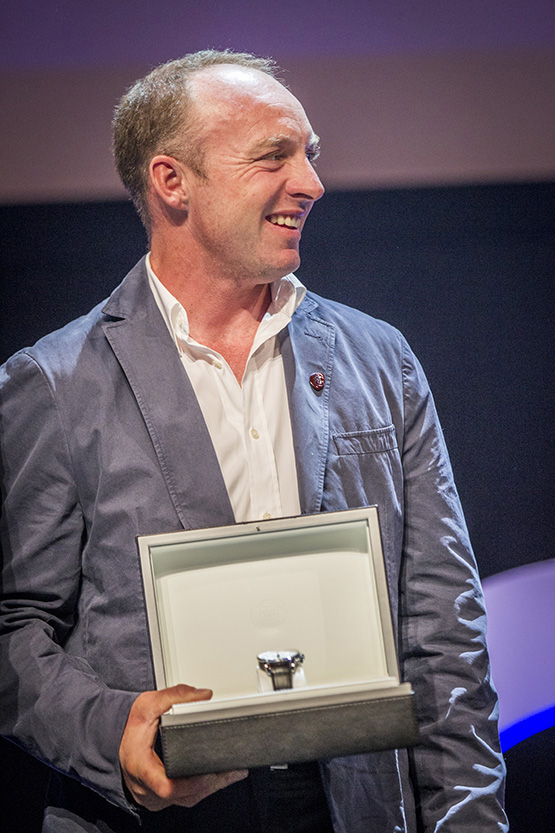
Justin Slattery at the Volvo Race Awards Ceremony in Gothenburg
CLICK the podcast at the top of this blog to listen to the interview.
One of my prized sailing possessions is a cap which Justin gave me after he won his first Volvo Race and which he had worn aboard AN AMRO ONE.. There is a story to it. When my boat was broken into and damaged on its mooring at Crosshaven a few years ago, that hat was amongst the items stolen. An alert Garda detective spotted a man wearing it in Cobh and, with sailing knowledge, questioned him as to where he got it. That led to an outcome where quite a bit of stolen boating equipment was found, including some of mine and Justin’s hat, which was returned to me and which I still use, as the photo shows!
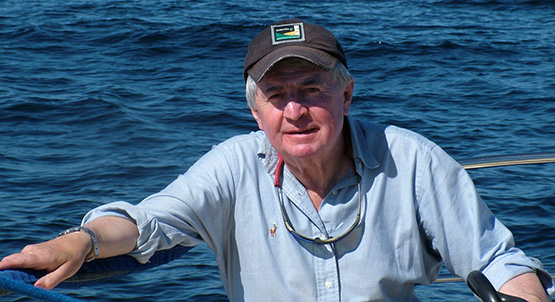
The hat that survived thieves
#vor – Cork's Justin Slattery along with skipper Ian Walker and the rest of the victorious Abu Dhabi Ocean Racing crew have presented His Highness Sheikh Mohammed bin Zayed Al Nahyan, the Crown Prince of Abu Dhabi, with the Volvo Ocean Race 2014-15 trophy.
Briton Walker and Ireland's Justin Slattery, who won Afloat's Sailor the month award in June, described the meeting last week as the highlight of the visit that followed their victory in Gothenburg at the end of last month.
The all-conquering crew of eight also clinched the Volvo Ocean Race In-Port Series Trophy on June 27 in the Swedish port among several other victories including the IWC 24-Hour Speed Record Challenge and the Inmarsat Onboard Reporter Award, won by Matt Knighton (USA).
They also met the chairman of backers Abu Dhabi Tourism & Culture Authority (TCA Abu Dhabi), His Highness Sheikh Sultan Bin Tahnoon Al Nahyan, during the visit to the team's home country.
Walker believes that only part of the mission has been completed following victory in the nine-month offshore race – he still has an ambition to grow the sport of sailing in the region.
"Getting sailing on the front pages of the newspapers and encouraging school kids to read about and see it, it's a great thing," he said.
"But sailing's not going to grow here without a lot of work at the grassroots level and I think that's the challenge now; to take the message out into the schools and the clubs and to try to get kids in boats.
"It's a great sport, it's healthy, it's outdoors and the climate's fantastic, certainly nine months of the year - with ideal sailing conditions. Hopefully, we can use this win as a springboard to build on.
"And I think it's already happening. You see more and more boats off the Corniche here in Abu Dhabi. But we'd really like to see that grow 10-fold over the next few years."
The crew's Emirati sailor, Adil Khalid, added: "This is the greatest moment of my life. I am immensely proud for my crewmates and my country.
"The United Arab Emirates flag has been flown proudly at every stopover throughout the race and now we have sealed a wonderful victory, our fans in the UAE and around the world can celebrate."
Many have asked whether Abu Dhabi Ocean Racing will return for a third Volvo Ocean Race campaign, but TCA Abu Dhabi has made it clear that no decision will be made for several months.
Walker added: "Hopefully, the Abu Dhabi Sports Council and the Tourism & Culture Authority will come up with new ways to move sailing forward and we've created this fantastic brand. For sure I'd love to be involved again and I hope it moves forward in a way that I can be involved.
"Right now we're just enjoying the moment, sharing it with as many people as we can. We'll have a holiday and then we'll take stock."
The achievement of Walker and his men has been lauded by the campaign's chief supporters.
"The Volvo Ocean Race is rightly regarded as the 'Everest of Sailing', the pinnacle of offshore sailing challenges, and Abu Dhabi Ocean Racing has made it to the top." said Sheikh Sultan.
"From the start of the race in Alicante, it's been an incredible competition in the face of some of the most challenging and dangerous conditions our planet has to offer.
"I am tremendously proud of our skipper Ian Walker, our Emirati sailor, Adil Khalid, and all Azzam's crew for securing first place in the 2014-15 edition of the race.
"It is another landmark achievement for the United Arab Emirates and the team has represented our emirate with bravery, distinction, and skill."
Sultan Al Dhaheri, Acting Executive Director of TCA Abu Dhabi, added: "The team has represented our country with pride as we competed against the best sailors in the world, and we've strengthened our position as a sailing nation in front of a global audience.
"I hope all the Abu Dhabi Ocean Racing fans in Abu Dhabi, and around the world, join me in congratulating all the members of our victorious team."
#vor – The clear win by Abu Dhabi Ocean Racing in the Volvo Ocean Race 2014-15 was achieved by solid consistency in the classic "good series" style favoured by regular champion sailors. Except that, instead of being a pleasant five day championship regatta staged at some agreeable summer venue, the Volvo Ocean Race was made up of nine legs which took the fleet right round the world, getting them south of both Good Hope and Cape Horn, yet also back north again across the equator.
In such a challenge, a mixture of experience and exceptional sailing talent is at a premium, and Ireland's Justin Slattery (40) has both in abundance. He was a key crew member aboard Abu Dhabi, which was well placed top of the leaderboard with a scoreline of 1,3,2,2,1 after the first five legs. But with four legs still to be raced, experience became the key ingredient, as the leading boat has to defend her position against a chasing fleet in which, with three close contenders, the likelihood of one of them taking an uncoverable but successful tactical gamble becomes ever more acute.
That, and the cruel possibility of damage or even a dismasting, are among the many threats which a crew defending a good first place has to face, and skill and experience become paramount. But the crew of Abu Dhabi kept their cool, they kept their boat intact, and they sailed on to win overall by 24 points to the 29 of Team Brunel and the 33 of Dongfeng Race Team, making Justin Slattery the winner of an Afloat.ie International Award for June 2015.
#vor – Abu Dhabi Ocean Racing (Ian Walker/GBR) buried the miserable memories of the Volvo Ocean Race three years ago to win an epic Southern Ocean/south Atlantic crossing in Leg 5 and claim their second stage victory in the Volvo Ocean Race 2014-15. Wexford's Justin Slattery is part of Walker's crew racing as bowman on the favourite in the five boat fleet.
In 2012, Walker's crew were forced to return to Auckland with hull damage and eventually retired from the leg to Itajaí, Brazil.
They must have feared more of the same when Cyclone Pam delayed the departure from New Zealand for three days, but despite taking the worst that the Southern Ocean and then the south Atlantic could throw at them, the Emirati team emerged triumphant after nearly 19 days of ultra-challenging, super-tight sailing.
Amazingly, skipper Ian Walker reported that they had reached Itajaí with the least amount of work for their shore crew to do of any leg so far in this edition.
To add the icing to their cake, Abu Dhabi Ocean Racing set the new best mark in the chase for IWC prize for the most nautical miles (nm) sailed in 24 hours with 551nm leading up to Cape Horn.
The stage victory leaves Walker's team seven points clear at the top of the standings with five of the nine legs now completed.
Leg 5 finishing times
1. Abu Dhabi Ocean Racing - 18 days 23 hours 30 minutes 10 seconds
2. MAFPRE - 19d 00h 02min 56s
3. Team Alvimedica - 19d 00h 24min 32s
4. Team Brunel - 19d 00h 25min 48s
Team SCA (Sam Davies/GBR) had more than their share of problems, damaging three sails and then suffering a port rudder breakage on Sunday. They are expected to finish the leg on Tuesday.
Justin Slattery, Volvo Ocean Racer, is Sailor of the Month for November
#sailorofthemonth – Successes in the first two races of the current Volvo Ocean global contest have placed Justin Slattery in an unassailable position for our Sailor of the Month for November. Completely absorbed in his fifth world race which is itself a record for an Irish sailor (and he won in 2005-06 with ABN Amro), Slattery has had the satisfaction of seeing his Abu Dhabi team justify his feeling that on the previous circuit three years ago, they were hampered by a slow boat when the fleet was made up of different individual boats from a number of designers and builders, even if constructed within closely-limited parameters.
For the 2014-2015 contest, they are of course racing the one-design Volvo Ocean 65s, created by Farr Yacht Design. Although Abu Dhabi - skippered by Ian Walker - was not necessarily always in the lead on the first leg from Alicante to Cape Town, she was ahead when it mattered at the finish. And with the entire fleet of one designs racing within the same closely defined area of water for the Cape Town inshore event, she showed the quality and depth of her style with another win. In the thick of it all, Justin Slattery was in his usual key roles in a multi-functional position (he can be bowman, trimmer or helmsman) to fulfill expectations that have resulted in him being very much the man to go to when putting together a sailing team – his days of knocking on doors in the hope of securing a crew place are happily long gone.
Born in Cork with a boyhood in Wexford, Justin Slattery (40) is another Irish sailor who took his first proper steps afloat with Eddie English on Cork Harbour. For those keen to follow in his career path, his basic advice is to keep going for it, and do just as many offshore races as you can manage to get invited on, both to develop general experience, and to test whether or not you have the hundred per cent dedication needed. It is also important to develop specialisation in one particular skill in gear, equipment or sails which will give you a personal USP when crews are being assembled.




























